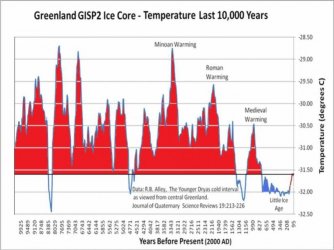Trajan
conscientia mille testes
 can't be...can it?
can't be...can it? Only 9,099 Of Last 10,500 Years Warmer Than 2010
Another graph of temperatures from the Greenland ice core for the past 10,000 years is shown in Figure 5. It shows essentially the same temperatures as Cuffy and Clow (1997) but with somewhat greater detail. What both of these temperature curves show is that virtually all of the past 10,000 years has been warmer than the present.
Figure 5. Temperatures over the past 10,000 years recorded in the GISP2 Greenland ice core
Only 9,099 Of Last 10,500 Years Warmer Than 2010 - By Brian Bolduc - Planet Gore - National Review Online



